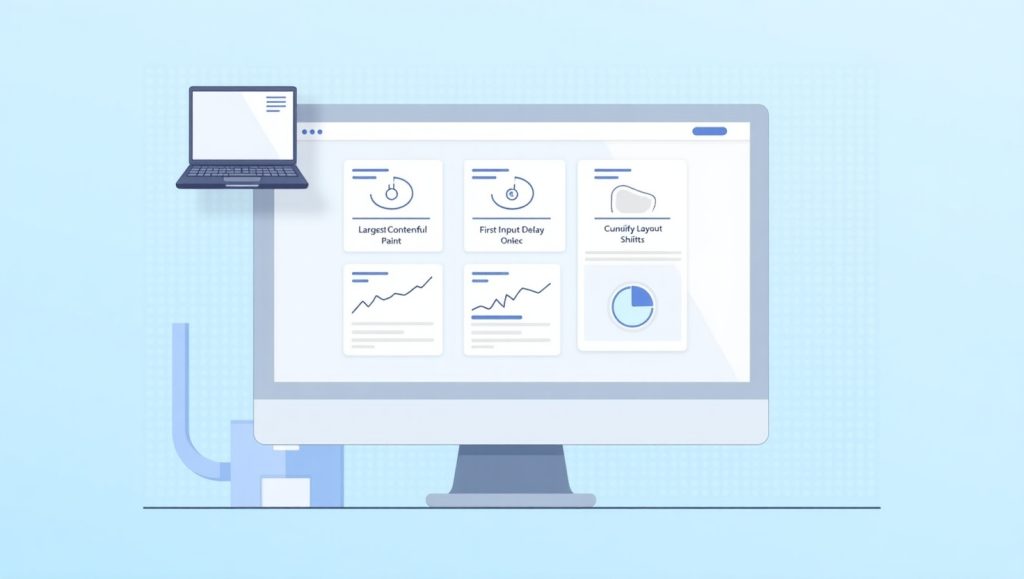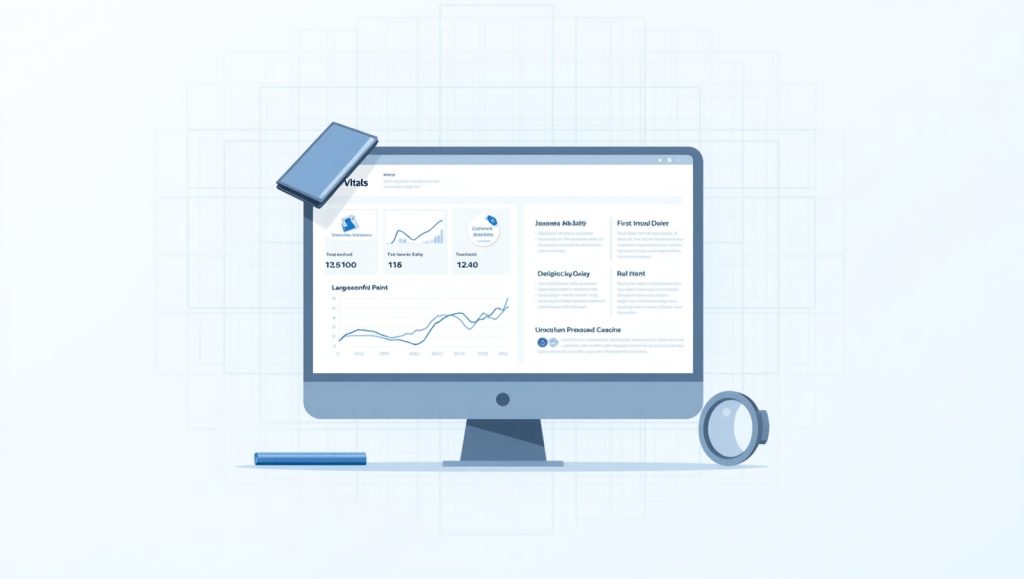
Why Monitoring Web Vitals Matters in 2025
In 2025, the digital experience is more important than ever. Websites are not just digital brochures; they are full engagement platforms. This is where Web Vitals come into play. These metrics come straight from Google and measure real-world user experience in the areas of loading performance, interactivity, and visual stability. But it is one thing to know these metrics exist—additional work is needed for site designers and developers to have a real-time tool set to measure and act on these metrics continuously.
Why is this important? Search engines have begun considering Core Web Vitals (CWV) metrics as part of the ranking factors. If your site is slow, or buggy, your web pages can drop in the SERPs with no recourse for the poor user experience experience, even if your content is “great”. Additionally, web performance sends users fleeing. You can lose customers without them ever engaging with your product.
Key metrics are Largest Contentful Paint (LCP), First Input Delay (FID), and Cumulative Layout Shift (CLS). These metrics measure how fast the site loads, responds, and how stable it is visually. With so many variables, your monitoring efforts will benefit from the right tools to stay ahead of things.
If you are managing say a website design project, or concerned with a significant content platform, you should not only pay attention to these critical metrics post-live, but at the various stages of development as well. Tools are available that can allow for real-time or historical performance data tracking and suggestions on how you can keep your users from losing the experience that you have intended.
This article will provide some tools that some professionals are using to track web vitals – and why it matters.
Top Free Tools for Monitoring Web Vitals
Google PageSpeed Insights
Google PageSpeed Insights (PSI) is a classic tool for web developers. It reports on your performance by using a robust performance report that combines lab data, as well as Chrome User Experience Report (CrUX) real user experience data. The best part of PSI is how accessible it is as it is free and has no setup.
With PSI it can give you what your Core Web Vitals scores are as well as fixes depending on what performance issues are highlighted. PSI breaks everything down with colours, green for good, orange for needs improvement, and red for poor. So you can follow everything visually and use common sense to figure your issues out even if you are not a developer.
Another thing PSI gave you is desktop and mobile performance reports. In a mobile-first world, that is critical. Whether you are working with a WordPress site or a custom platform, PSI helps you adjust your performance quickly and effectively.
In addition, its great integration with Google means you can align your performance as best as you can with SEO, in keeping with best practices. It might not be the most detailed real-time monitoring as some premium tools, but it is a great tool to start from for vetting and ongoing diagnostics improvements.
Lighthouse by Google Chrome
Lighthouse is yet another valuable resource from Google, and being part of Chrome DevTools means you don’t even have to install anything. Just open DevTools on any page and run a Lighthouse audit.
Unlike PageSpeed Insights, you get to simulate slower connections and slower CPU speeds with Lighthouse. This is great for putting your site through stress testing. It also provides a performance score, but other factors are also audited for accessibility, SEO, and best practices, making it perhaps the most all-in-one free tool available.
Lighthouse does a fantastic job of breaking down and inspecting each Web Vital metric and should be used continuously during the development phase of a project. For example, if you are involved in web design Cardiff projects, Lighthouse will help you understand how each page element will contribute to a positive user experience.
The downside is that lab data doesn’t reflect real user data. However, figuring out where potential performance bottlenecks could arise, before launching, is exactly what it’s for.
Premium Tools for In-Depth Web Vitals Tracking
WebPageTest
This tool, WebPageTest, is much more advanced than just that. You can run a test on specific browsers, networks conditions, geographic locations, and other testing options. This is a tremendous help for organizations that serve a global audience and need to ensure performance is consistent in regions of focus.
WebPagetest provides a unique filmstrip view, waterfall charts, and scores broken down for Core Web Vitals. Developers appreciate (and some may call “love”) WebPageTest for how transparent it is to their users with regards controllable test environments. You will spend some time learning how to utilize all of its features, but once you do, you will unlock a treasure trove of findings.
A very cool feature is the visual comparison test. You can test different URLs side-by-side to see which performed better for the test conditions defined. This could be a really useful tool for an agency doing A/B testing or for contractors attempting to sell design changes to client.
You have a free tier option, which is cool, but obviously, you are missing the majority of WebPageTest’s capabilities. The Low Monthly Premium Plan will give you access to most of their power at a very low cost; however, if you are managing multiple high traffic websites it can be woth the cost.
New Relic
New Relic is a real-time performance monitoring and analytics solution for web applications. It’s an enterprise-level solution commonly used by large corporations to ensure their digital assets are operating at uptime, speed, and performance levels.
RUM, synthetic testing, Web Vitals tracking, etc. come in their suite. You can even drill down performance by user sessions, browsers, locations, etc. If you want to directly tie Web Vitals to revenue, user behavior, etc., New Relic is exceedingly powerful.
New Relic will allow you to set automated alerts, for instance, if your LCP or CLS suddenly drops below a certain threshold you will receive an immediate alert. This means your team can react in real-time, which is important for upholding the trust of your customers and preventing bounce-offs.
While New Relic has a cost, if you are searching for a robust, scalable monitoring system with deep insights, it’s quite possibly the best in the business.
Browser-Based Tools for Developers and Designers

Chrome User Experience Report (CrUX)
CrUX is a massive amount of real-user data from Chrome browsers across the world. There’s nothing to install, and you have no changes to make to your site. It gathers performance data and creates datasets that you can access via BigQuery or the CrUX Dashboard.
It is a great tool to find trends. For example, if your users in a specific country have an increase in CLS issues, CrUX could help you discover it. “When combined with Google Data Studio, you can create interactive dashboards that the team can make sense of and anchor up to.…”
But you will need to learn CrUX and it has a bit of a learning curve. The best usage is to use in combination with tools such as Lighthouse or PSI to see the full picture. It is invaluable for insights when making decisions and gathering data.
Web Vitals Chrome Extension
There are times when you want simple answers without needing to run complete reports. The Web Vitals Chrome Extension allows you to do just that. Once installed, Web Vitals will provide you with real time Web Vitals scores in your browser bar for any page you are on.
It is great for designers or QA testers that want to confirm fixes right away, or for comparing the performance of competitors’ sites. It’s not meant to replace more in depth tools like New Relic or WebPageTest, but for a daily check and quick validation it is very helpful.
Conclusion
Selecting the appropriate tools for monitoring Web Vitals will ultimately depend on your goals, the size of your team, and your technical knowledge. For freelancers and smaller agencies, Google PageSpeed Insights and Lighthouse could be a great free starting point. If you’re working on larger projects, full of data (for example web design Penarth), you may find WebPageTest or New Relic offers the level of accuracy and scalability you need when monitoring Web Vitals.
The most important thing is consistency. Monitoring Web Vitals should not be a one-off activity. It needs to be a continued commitment to ensure you deliver the best experience possible to your users; one which can lead to higher user engagement, improved search results and progressed customer satisfaction.
Regardless of budget or tech stack, any of the tools we mention here should help you find some clarity and direction. Don’t wait for your bounce rate to hit the fan. Start optimizing now, focus your digital presence for speed, stability and user-friendliness.